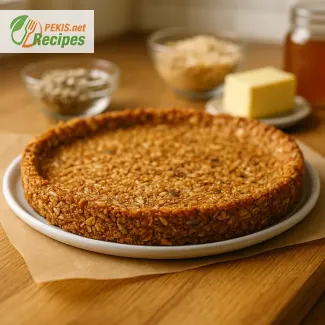Soft and buttery St. Nicholas Croissants make 12 golden crescents in just 25 minutes of prep and 20 minutes of baking, perfect for cozy winter mornings. Made with flour, yeast, milk, and butter, these flaky pastries rise to delicate layers with a hint of vanilla and lemon zest. They keep well for 2–3 days in an airtight container and can be frozen before baking for a fresh holiday treat anytime. Lightly dusted with powdered sugar, they bring the warm scent of tradition straight to your breakfast table.
Years of working with European holiday pastries taught the importance of patience, precise temperature, and the beauty of simple ingredients. Every batch of St. Nicholas Croissants reminds how butter, milk, and time can turn a humble dough into something truly festive — soft inside, golden outside, and filled with the scent of home.
PEKIS – a professional chef and recipe developer with over 25 years of experience in cooking and baking, specializing in European and international cuisine.

Golden St. Nicholas Croissants: A Buttery Symbol of Holiday Warmth
Flaky, aromatic, and deeply rooted in festive European baking traditions
When the scent of warm butter, vanilla, and toasted almonds fills the kitchen, it signals that St. Nicholas Day is approaching — a celebration of generosity, sweetness, and comfort. These golden, crescent-shaped pastries, inspired by Central European traditions, are not merely a breakfast treat; they are a gesture of warmth, hospitality, and anticipation for the holiday season. Their delicate layers of dough, tender interior, and subtle notes of citrus zest and vanilla sugar bring a nostalgic charm that instantly evokes the cozy glow of winter mornings.
The story behind St. Nicholas croissants
In many regions of Europe — from Austria and Germany to Slovenia and the Czech Republic — St. Nicholas Day marks the beginning of the Christmas festivities. Children polish their shoes and place them by the window, waiting for small gifts, nuts, or sweet pastries. Over centuries, the croissant-like pastry associated with this day evolved from a simple yeast dough enriched with milk, butter, and eggs into an elegant, buttery crescent symbolizing prosperity and light. Each fold captures not only air but also history — the art of patient baking passed down through generations.
The flavor and texture
The hallmark of St. Nicholas Croissants is their rich, buttery dough, which rises slowly to create an airy, layered structure. A touch of honey or vanilla sugar enhances the sweetness, while finely ground nuts or marzipan can be added for extra depth. Once baked, the pastries emerge with a golden crust and tender crumb, dusted with powdered sugar that glistens like early winter frost. Every bite balances delicate crispness with melt-in-your-mouth softness — a harmony that defines true festive indulgence.
Why you’ll love this recipe
• Authentic tradition – A pastry that brings together centuries of European holiday heritage.
• Irresistible texture – Flaky on the outside, soft and buttery on the inside.
• Comforting aroma – Notes of vanilla, citrus, and butter that fill your home with warmth.
• Versatile enjoyment – Perfect for breakfast, brunch, or a sweet afternoon treat.
• Make-ahead friendly – The dough can rest overnight for even richer flavor.
Ingredients that make a difference
Each ingredient plays a vital role in shaping the final flavor and texture. High-quality butter ensures the croissants stay tender and aromatic, while fresh yeast creates a naturally light rise. Whole milk adds richness, sugar balances the flavor, and a pinch of salt enhances the buttery notes. Some regional variations include lemon or orange zest for freshness or a hint of rum for warmth. The layering process — folding and resting the dough — allows thin sheets of butter to form delicate air pockets during baking, giving that signature flaky structure.
Preparation and make-ahead tips
St. Nicholas Croissants benefit from slow, careful preparation. After the dough has rested and been folded multiple times, it can be refrigerated overnight, making it ideal for baking in the morning. This resting time enhances both texture and flavor, giving the butter time to solidify and the yeast to develop subtle sweetness. Once shaped into crescents, they can be frozen before baking and baked directly from the freezer — a practical option for busy holiday mornings.
A festive connection to other traditions
Across Europe, each country celebrates St. Nicholas Day with unique specialties — from gingerbread figures in Germany to sweet rolls in the Netherlands. The St. Nicholas Croissant, however, stands out as a universal favorite — humble yet elegant, perfect for sharing. It pairs beautifully with hot cocoa, mulled wine, or warm milk, turning a simple breakfast into a small festive ritual.
More delightful ideas for your holiday table
For those who love experimenting with festive flavors, discover more St. Nicholas–inspired treats:
- How to prepare a perfect St. Nicholas breakfast
- How to Create the Perfect St. Nicholas Chocolate Roll Cake
Creative variations
• Nut filling: Spread a thin layer of ground hazelnuts or almonds mixed with honey before rolling.
• Chocolate swirl: Add a hint of dark chocolate or cocoa powder to the dough for a richer twist.
• Citrus glaze: Finish with a simple icing made from lemon juice and powdered sugar for brightness.
• Mini versions: Shape smaller crescents and serve them as festive bites alongside coffee or tea.
• Spiced version: Add ground cinnamon or cardamom for an aromatic winter flavor.
Sensory profile and serving suggestion
The buttery aroma, the soft crumble of the pastry, and the delicate sweetness combine into a sensory experience that feels both nostalgic and luxurious. Serve the croissants slightly warm, allowing the layers to reveal their texture with each bite. A touch of powdered sugar or vanilla glaze makes them glisten beautifully on the table — an irresistible centerpiece for your holiday mornings.
Cultural and emotional significance
Beyond their flavor, St. Nicholas Croissants embody the spirit of generosity and sharing. Baking them together with family becomes a cherished ritual — teaching patience, joy, and appreciation for handmade food. In a world that moves quickly, this traditional recipe invites you to slow down, savor the moment, and bring a little magic to your December mornings.
- Activate the yeast: Warm the milk to about 37°C (98°F). Add yeast and 1 teaspoon of sugar, mix gently, and let it rest for 10 minutes until frothy.
- Combine dry ingredients: In a large bowl, mix flour, remaining sugar, salt, vanilla sugar, and lemon zest.
- Form the dough: Add the yeast mixture and egg yolks, then slowly incorporate softened butter. Knead until the dough becomes smooth and elastic.
- First rise: Cover with a clean cloth and let rest for 45–60 minutes at room temperature until doubled in size.
- Shape the croissants: Roll the dough into a rectangle about 0.5 cm (0.2 inch) thick. Cut into triangles and, if desired, add a teaspoon of ground almonds near the base. Roll tightly toward the tip to form crescents.
- Second rise: Place on a baking tray lined with parchment paper, cover lightly, and let rise again for 30 minutes.
- Preheat and brush: Preheat the oven to 180°C (356°F). Brush each croissant with beaten egg and a bit of melted butter for extra shine.
- Bake: Bake for 18–20 minutes until golden brown and flaky.
- Finishing touch: While still warm, lightly brush with honey or dust with powdered sugar for a festive look.
- Serve: Enjoy warm or at room temperature with hot cocoa, coffee, or mulled wine.
FAQ questionHow do I keep St. Nicholas Croissants soft for longer?
To keep the croissants soft, let them cool completely on a rack, then store them in an airtight container or a tin lined with baking paper. Because the dough is enriched with milk, butter, and egg yolks, it stays tender for 1–2 days. If they start to dry, warm them in the oven at 150°C (302°F) for 3–4 minutes. Avoid storing them in the fridge, as that speeds up staling.
FAQ questionCan I prepare the dough the day before?
Yes. This is actually better for flavor and structure. After kneading, let the dough rise once, then cover it and refrigerate overnight. Cold dough is easier to roll, cut, and shape into crescents. The next day, shape, let them proof at room temperature for 30–40 minutes, then bake as usual. Long, cold fermentation develops a deeper buttery aroma.
FAQ questionCan I fill St. Nicholas Croissants with something sweet?
Absolutely. Traditional versions are often plain, but you can add ground almonds, hazelnuts, marzipan, plum jam, or thick vanilla cream near the base before rolling. Choose a filling that is not too runny, otherwise it will leak during baking. A thin layer is enough — the star of this pastry is still the flaky, buttery dough.
FAQ questionWhat if I don’t have fresh yeast?
You can use active dry yeast or instant yeast instead. Replace 25 g fresh yeast with 8 g (2 ¼ tsp) active dry yeast. Dissolve it in lukewarm milk with a bit of sugar and let it foam. The rest of the recipe stays the same. Make sure the milk is not hotter than 37°C (98°F) so the yeast stays active.
FAQ questionCan I freeze St. Nicholas Croissants?
Yes, and it’s very practical for the holidays. Shape the croissants and place them on a tray to freeze unbaked. Once firm, transfer to a freezer bag. When needed, place them on a lined tray, let them thaw and proof for 60–90 minutes, then bake. This way you always get freshly baked, warm croissants without making the dough from scratch.
FAQ questionWhy is lemon zest or vanilla added to the dough?
These croissants are meant to feel festive and seasonal, so a touch of lemon zest, orange zest, or vanilla sugar gives a gentle aroma that pairs well with winter drinks. It doesn’t make the dough sour — it just lifts the flavor and makes the pastry taste more elegant and “holiday-like.”
FAQ questionHow do I make them look shiny and golden like in bakeries?
The secret is double glazing. First brush with beaten egg before baking to get color. Then, right after baking, brush lightly with melted butter or warm honey. The result is a golden, glossy surface that looks professional and keeps the crust from drying out.
The comforting aroma of butter and vanilla filling the kitchen captures the essence of holiday mornings. St. Nicholas Croissants bring together generations of European baking tradition in a form that’s timeless, simple, and full of warmth. Each crescent, with its flaky golden layers, tells a story of patience, care, and celebration.
The texture of the dough — light, tender, and slightly sweet — pairs beautifully with any festive drink, from rich hot chocolate to spiced mulled wine. What makes these croissants special is their versatility: they can be served plain for breakfast, filled with almonds or jam for dessert, or enjoyed warm straight from the oven on a snowy December morning.
Their preparation reflects the true rhythm of holiday baking — slow, mindful, and deeply rewarding. From the first rise of the dough to the moment they’re brushed with melted butter and honey, every step adds to their delicate flavor. This process turns a few simple ingredients into something extraordinary and heartfelt.
Whether shared at the family table or wrapped as a small homemade gift, St. Nicholas Croissants embody the joy of giving. They remind us that the finest holiday memories often come not from perfection, but from the warmth of freshly baked pastry and the people gathered around it.
Allergens present in the recipe
- Gluten – present in wheat flour; replace with a gluten-free all-purpose blend.
- Milk – found in butter and milk; replace with lactose-free milk and plant-based butter.
- Eggs – used for binding and glazing; replace with flaxseed gel (1 tbsp ground flax + 3 tbsp water).
- Nuts – present in almond filling; omit or use finely ground sunflower seeds as an alternative.
- Vitamin A – 85 µg – supports healthy skin and vision.
- Calcium – 48 mg – contributes to bone and dental strength.
- Iron – 1.2 mg – essential for oxygen transport and energy production.
- Vitamin B2 (Riboflavin) – 0.12 mg – helps convert food into energy.
- Magnesium – 12 mg – supports muscle and nerve function.
- Phosphorus – 65 mg – aids in bone mineralization and energy metabolism.
- Vitamin E – 0.6 mg – helps protect cells from oxidative damage.
- Beta-carotene – 0.3 mg – supports immune function and healthy skin.
- Polyphenols – 12 mg – contribute to heart health and reduce inflammation.
- Lutein – 0.1 mg – supports eye health and vision protection.





